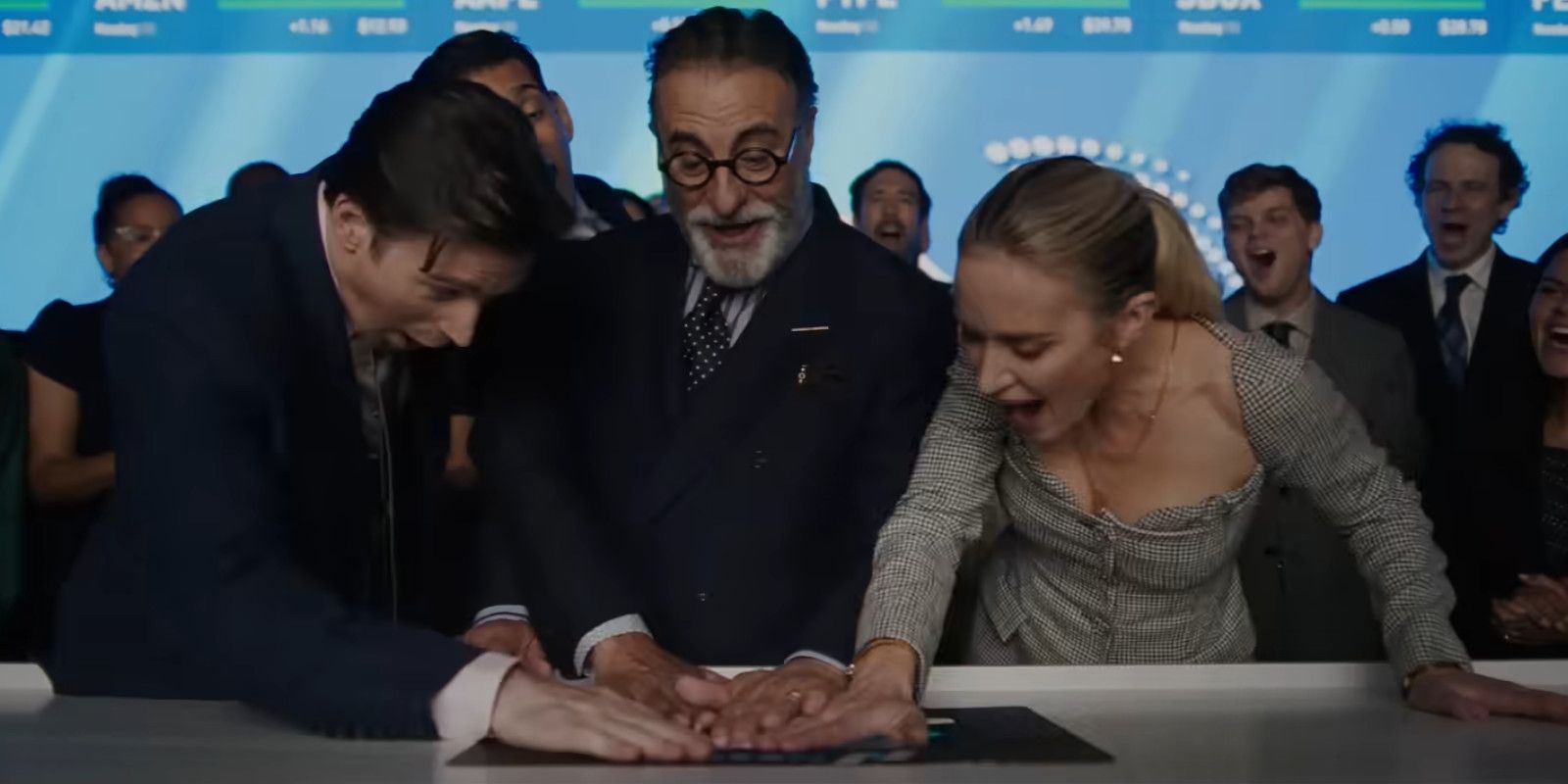
Pain Hustlers Ending Explained
Summary
- Pain Hustlers explores the cost of greed and the role of the pharmaceutical industry in the fentanyl crisis in the United States.
- While the backdrop of the opioid crisis is based on real events, the characters and companies in Pain Hustlers are fictional, with some inspiration drawn from real-life companies like Insys Therapeutics.
- The surge in addiction and deaths in the movie is a result of Zanna’s corrupt sales strategy, which involved bribing doctors and promoting off-label use of the drug Lonafen.
Warning: Contains SPOILERS for Pain Hustlers.The ending of Pain Hustlers reveals the cost of greed and the pharmaceutical industry’s role tragedy of the fentanyl crisis in the United States. Directed by David Yates, Pain Hustlers is a Netflix original featuring Emily Blunt and Chris Evans in a story based on the book “The Hard Sell: Crime and Punishment at an Opioid Startup” by journalist Evan Hughes, adapted to a screenplay by
Wells Tower.
In Pain Hustlers, Liza Drake (Emily Blunt) is a down-on-her-luck mom struggling to find gainful employment so she can take care of her daughter’s epilepsy when she’s offered a job by a Zanna pharmaceutical representative, David Brenner (Chris Evans) selling a fentanyl product, Lonafen. Liza and David quickly start skirting the boundaries of the law to sell Lonafen, but it isn’t long before Zanna’s entire business model hinges on multiple illegal activities, encouraged by the company’s principal investor, Dr. Jack Neel (Andy Garcia). As the Fentanyl crisis gets worse, Liza’s conscience gets the better of her and she becomes a whistleblower to help take the whole company down.
Is Pain Hustlers a True Story?
Pain Hustlers opens with the text “what you are about to see is inspired by actual events,” but that doesn’t mean all the characters and events in Pain Hustlers are real. While the backdrop of the opioid crisis and the way pharmaceutical companies pushed fentanyl products is generally accurate to real life, the characters in Pain Hustlers are all fictional as are Zanna and most of its competitors (although real companies like Pfizer are mentioned). Fentanyl is a very real drug, and there is a real-life pain-relief drug called Lonafen, although it has no similarities to the fictionalized Lonafen in Pain Hustlers.
The real-life company written about in Evan Hughes’ book, “The Hard Sell: Crime and Punishment at an Opioid Startup” is Insys Therapeutics, and their product was a sublingual (under the tongue) fentanyl liquid (just like Pain Hustlers’ Lonafen) called Subsys. Insys’ founder, John Kapoor, has a backstory very similar to Dr. Jack Neel’s in Pain Hustlers, and their business model, bribing doctors to prescribe Subsys to patients, was virtually identical to Zanna’s strategy for selling Lonafen in Pain Hustlers.
Many other aspects of Zanna in Pain Hustlers are taken directly from Insys, including parties at strip clubs and gifting doctors with steak and other expensive gifts. Even the outrageous rap performed by Chris Evans’ David Brenner at the sales meeting is directly inspired by a similar real-life video, partially shown at the end of Pain Hustlers, featuring sales reps in costume rapping about titration and profits from dose increase. As with Zanna at the end of Pain Hustlers, Insys Therapeutics was ultimately taken down when a sales rep, Maria Guzman, became a whistleblower, although Liza Drake’s story is otherwise significantly different from Guzman’s.
How Did Liza Pay For Phoebe’s Surgery?

Liza almost quit selling Lonafen before making her first sale because she’d been rejected by every doctor on her list and wanted to find a more stable environment for Phoebe (Chloe Coleman) after she had a seizure. The doctor explained she could need a surgery to fix the seizures. One method involved cutting opening up part of her skull to scoop out the “ateriovenous malformation” (AVM) like a “melon baller.” The second option is far less invasive and less risky and involved entry via the nose without cutting into her skull or moving her brain. Unfortunately, the second option wasn’t covered by Medicaid.
After Liza finds success getting doctors like Dr. Nathan Lydell (Brian d’Arcy James) to prescribe Lonafen, she’s making enough money to afford a far more extravagant lifestyle with an expensive house, nice clothes, fancy cars, and an expensive school for Phoebe. Unfortunately, when it turns out Phoebe still needs the surgery, Liza doesn’t have enough money to cover it because insurance still won’t cover it, she doesn’t have enough saved up, she can’t access her company stock until it vests after she’s been with the company for a year, and she’s denied a loan because the pharmaceutical industry is too volatile.
Liza eventually tries to ask Dr. Neel for help paying for the surgery, but he tells her Phoebe’s condition could be a “secret gift” she should use the situation to motivate her to increase sales. It’s never explicitly stated in dialogue, but the visible incision on the side of Phoebe’s head when she’s recovering from the surgery is confirmation that she ended up getting the riskier, more invasive surgery. Despite the increased risk, she seems to recover just fine, meaning none of Liza’s participation in Zanna’s corruption even had an impact on her daughter’s surgery at the end of the day.
Why Did Lonafen Patients Start Dying?

Early in the movie, David Brenner cites the “Hartigan study out of Mass General” putting Lonafen at less than 1 percent risk of addiction or overdose. The Hartigan study is entirely fictional, but at the end of the movie, Elliot Hartigan, the fictional author of the study, explains the study only related to clinically controlled doses to opiate-resistant stage 4 terminal cancer patients. In that setting, the risk of adverse effects from overdosing is virtually eliminated, and many of the patients died from cancer before any longer-term side effects manifested.
Zanna’s sales strategy initially followed a similar structure to the Hartigan study, so the surge in addiction, overdose, and deaths didn’t begin until the company began bribing doctors to prescribe Lonafen “off-label” to non-cancer patients and incentivized increasing doses. It’s not clear if there’s an equivalent real-life study, although the way Zanna abuses the Hartigan study in Pain Hustlers resembles real-life abuse of scientific studies to twist or distort the findings.
Why Jackie’s Emails Were the Key For Liza Taking Down Jack and Zanna

After initially approaching the Florida District Attorney to blow the whistle on Zanna’s corrupt business practices, Liza says it’d be nearly impossible to implicate Dr. Jack Neel in the bribery scheme because he doesn’t email or a smartphone or allow any electronic devices near him. The only way it could be suggested he was even aware of the bribery scheme would be through notes he gives to David Brenner, but when Liza tries to steal David’s copy of the notes, she’s caught.
Despite Jack’s paranoia and security around creating a paper trail, his brief romantic fling with Liza’s mom, Jackie Drake (Catherine O’Hara), unintentionally proved he was fully aware of (and participating in) Zanna’s bribery of doctors. Jackie tried to email Jack to leverage their relationship to get herself better deals and more commission pay. In the emails, she explicitly referenced payout amounts and used the word “bribe money,” so, while Jack didn’t ultimately acquiesce to any of Jackie’s requests (and, in fact, told Liza to fire her), the emails proved his legal defense claiming he had no knowledge of or involvement of Zanna’s business decisions was a lie.
Pain Hustlers Full Ending and True Message Explained

Liza alerted the Florida District Attorney to Zanna’s corruption, revealed the entire bribery scheme, and provided the evidence necessary to convict multiple executives, including 16 months of jaul time for former CEO Eric Paley (Amit Shah), 36 months for CEO David Brenner, 66 months for Dr. Jack Neel, and 15 months for Liza Drake. While the district attorney recommended no jail time for Liza due to her essential involvement in the case and clear display of remorse, the judge still sentenced her to jail time due to the real pain and suffering caused by her role in the addictions and deaths caused by Zanna’s pushing of a fentanyl product.
The end of Pain Hustlers shows Liza and Jackie selling Jackie’s skin care product with many of the former Zanna reps Liza hired with David. Liza occasionally fantasizes about the money, success, and power she had while working for Zanna, but says it feels so good that it scares her. In many ways, her own ending resembles that of a drug addict in recovery, only instead of fentanyl, an opiate, or other drug, Liza experiences withdrawal from the power and greed of her old life.
No Byline Policy
Editorial Guidelines
Corrections Policy
Source